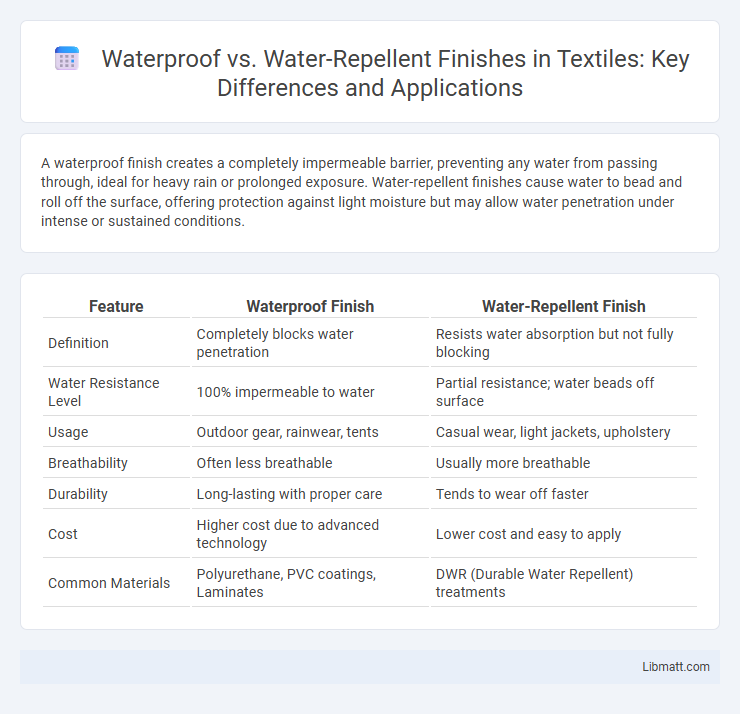A waterproof finish creates a completely impermeable barrier, preventing any water from passing through, ideal for heavy rain or prolonged exposure. Water-repellent finishes cause water to bead and roll off the surface, offering protection against light moisture but may allow water penetration under intense or sustained conditions.
Table of Comparison
| Feature | Waterproof Finish | Water-Repellent Finish |
|---|---|---|
| Definition | Completely blocks water penetration | Resists water absorption but not fully blocking |
| Water Resistance Level | 100% impermeable to water | Partial resistance; water beads off surface |
| Usage | Outdoor gear, rainwear, tents | Casual wear, light jackets, upholstery |
| Breathability | Often less breathable | Usually more breathable |
| Durability | Long-lasting with proper care | Tends to wear off faster |
| Cost | Higher cost due to advanced technology | Lower cost and easy to apply |
| Common Materials | Polyurethane, PVC coatings, Laminates | DWR (Durable Water Repellent) treatments |
Understanding Waterproof and Water-Repellent Finishes
Waterproof finishes create a barrier that completely prevents water penetration, making materials fully impermeable under wet conditions, ideal for outdoor gear and rainwear. Water-repellent finishes cause water to bead and roll off the surface but may allow moisture to seep through over time or under heavy exposure, providing moderate protection. Differentiating between these finishes is crucial for selecting appropriate fabrics based on intended use, exposure level, and durability requirements.
Key Differences Between Waterproof and Water-Repellent
Waterproof finish creates a completely impermeable barrier, preventing any water from penetrating the fabric, making it ideal for extreme wet conditions. Water-repellent finish, on the other hand, causes water to bead up and roll off but may allow moisture to seep through under prolonged exposure. Understanding these key differences helps you choose the best protection for your outdoor gear based on your specific environment and activity needs.
How Waterproof Finishes Work
Waterproof finishes create a non-porous barrier by using materials like polyurethane or PVC that prevent water molecules from penetrating the fabric entirely. These finishes often involve laminates or coatings that seal every fiber, ensuring complete resistance to water even under pressure or immersion. The effectiveness of waterproof finishes depends on factors such as the finish's thickness, bonding quality, and the garment's seam sealing techniques.
Mechanism Behind Water-Repellent Finishes
Water-repellent finishes work by creating a microscopic barrier that causes water to bead up and roll off the fabric surface, preventing absorption. This mechanism typically involves applying hydrophobic treatments such as silicone or fluoropolymer coatings that reduce the fabric's surface energy. Your clothing or gear with a water-repellent finish stays dry during light rain or splashes but may allow water to penetrate under heavy or prolonged exposure.
Common Materials for Waterproofing
Common materials for waterproofing include polyurethane, silicone, and PVC coatings, which create a durable barrier against water penetration. Water-repellent finishes often use treatments like DWR (Durable Water Repellent) that cause water to bead off fabric surfaces without fully sealing them. Your choice between these finishes depends on the level of water resistance needed and the specific material's breathability requirements.
Typical Water-Repellent Fabrics
Typical water-repellent fabrics include polyester, nylon, and treated cotton, which feature a durable coating that causes water to bead and roll off the surface. These fabrics offer breathability and light moisture resistance, making them ideal for everyday wear and light rain conditions. Unlike fully waterproof materials, water-repellent finishes do not create a complete barrier against heavy or prolonged water exposure.
Pros and Cons: Waterproof vs Water-Repellent
Waterproof finishes provide complete protection against water penetration, making them ideal for extreme wet conditions, but they can reduce breathability and may feel less comfortable during prolonged wear. Water-repellent finishes offer lightweight resistance by causing water to bead and roll off, enhancing comfort and breathability, yet they may lose effectiveness over time and during heavy exposure to moisture. Your choice depends on whether you prioritize maximum water protection or improved comfort and ventilation.
Ideal Uses for Waterproof Finishes
Waterproof finishes are ideal for outdoor gear, marine equipment, and construction materials exposed to prolonged water immersion or heavy rainfall. These finishes create a non-permeable barrier, preventing water from penetrating fabrics, wood, or metal surfaces. Ideal for hiking boots, rain jackets, and boat covers, waterproof coatings ensure durability and protection in extreme wet conditions.
Best Applications for Water-Repellent Coatings
Water-repellent coatings are ideal for fabrics exposed to light moisture, such as casual outerwear, umbrellas, and lightweight backpacks, where breathability and comfort remain priorities. These coatings create a hydrophobic barrier that causes water to bead and roll off without fully sealing the fabric, preserving airflow and reducing sweat buildup. Your gear stays dry during brief rain showers or splashes, making water-repellent finishes perfect for everyday use and active wear in mild weather conditions.
Choosing the Right Finish for Your Needs
Waterproof finishes create a fully impermeable barrier that prevents any water penetration, making them ideal for extreme weather or prolonged exposure conditions. Water-repellent finishes provide surface resistance by causing water to bead and roll off but may allow moisture infiltration during heavy or sustained contact. Selecting the right finish depends on the level of water protection required, with waterproof finishes suited for high-performance outdoor gear and water-repellent for everyday wear with light moisture exposure.
Waterproof vs Water-repellent finish Infographic

 libmatt.com
libmatt.com